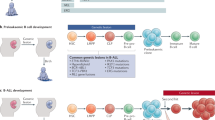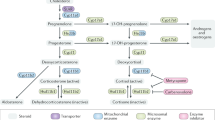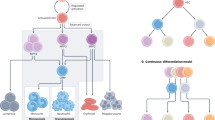Abstract
The pattern of infections in the first years of life modulates our immune system, and a low incidence of infections has been linked to an increased risk of common childhood acute lymphoblastic leukemia (ALL). We here present a new interpretation of these observations - the adrenal hypothesis - that proposes that the risk of childhood ALL is reduced when early childhood infections induce qualitative and quantitative changes in the hypothalamus–pituitary–adrenal axis that increase plasma cortisol levels. This may directly eliminate leukemic cells as well as preleukemic cells for the ALL subsets that dominate in the first 5–7 years of life and may furthermore suppress the Th1-dominated proinflammatory response to infections, and thus lower the proliferative stress on pre-existing preleukemic cells.
This is a preview of subscription content, access via your institution
Access options
Subscribe to this journal
Receive 12 print issues and online access
$259.00 per year
only $21.58 per issue
Buy this article
- Purchase on Springer Link
- Instant access to full article PDF
Prices may be subject to local taxes which are calculated during checkout


Similar content being viewed by others
References
Hjalgrim LL, Rostgaard K, Schmiegelow K, Soderhall S, Kolmannskog S, Vettenranta K et al. Age- and sex-specific incidence of childhood leukemia by immunophenotype in the Nordic countries. J Natl Cancer Inst 2003; 95: 1539–1544.
Schmiegelow K, Hjalgrim H . Is the risk of acute lymphoblastic leukemia reduced in siblings to children with the disease? A novel hypothesis explored by international collaboration. Leukemia 2006; 20: 1206–1208.
Stiller CA, Parkin DM . Geographic and ethnic variations in the incidence of childhood cancer. Br Med Bull 1996; 52: 682–703.
IARC. International Incidence of Childhood Cancer. IARC Scientific Publications: Lyon, 1998, 1–391.
Edgar K, Morgan A . Does infections cause or prevent childhood leukemia? 2008, 1–43.
Pieters R, Schrappe M, De LP, Hann I, De RG, Felice M et al. A treatment protocol for infants younger than 1 year with acute lymphoblastic leukaemia (Interfant-99): an observational study and a multicentre randomised trial. Lancet 2007; 370: 240–250.
Forestier E, Schmiegelow K . The incidence peaks of the childhood acute leukemias reflect specific cytogenetic aberrations. J Pediatr Hematol Oncol 2006; 28: 486–495.
Murray CJ, Laakso T, Shibuya K, Hill K, Lopez AD . Can we achieve millennium development goal 4? New analysis of country trends and forecasts of under-5 mortality to 2015. Lancet 2007; 370: 1040–1054.
Rajalekshmy KR, Abitha AR, Pramila R, Gnanasagar T, Shanta V . Immunophenotypic analysis of T-cell acute lymphoblastic leukaemia in Madras, India. Leuk Res 1997; 21: 119–124.
Mullighan CG, Goorha S, Radtke I, Miller CB, Coustan-Smith E, Dalton JD et al. Genome-wide analysis of genetic alterations in acute lymphoblastic leukaemia. Nature 2007; 446: 758–764.
Wiemels JL, Cazzaniga G, Daniotti M, Eden OB, Addison GM, Masera G et al. Prenatal origin of acute lymphoblastic leukaemia in children. Lancet 1999; 354: 1499–1503.
Wiemels JL, Ford AM, van Wering ER, Postma A, Greaves M . Protracted and variable latency of acute lymphoblastic leukemia after TEL-AML1 gene fusion in utero. Blood 1999; 94: 1057–1062.
Hjalgrim LL, Madsen HO, Melbye M, Jørgensen P, Christiansen M, Andersen MT et al. Presence of clone specific markers at birth in children with acute lymphoblastic leukemia. Br J Cancer 2002; 97: 994–999.
McHale CM, Wiemels JL, Zhang L, Ma X, Buffler PA, Guo W et al. Prenatal origin of TEL-AML1-positive acute lymphoblastic leukemia in children born in California. Genes Chromosomes Cancer 2003; 37: 36–43.
Zuna J, Muzikova K, Ford AM, Maia AT, Krejci O, Tousovska K et al. Pre-natal, clonal origin of acute lymphoblastic leukaemia in triplets. Leuk Lymphoma 2003; 44: 2099–2102.
Maia AT, Tussiwand R, Cazzaniga G, Rebulla P, Colman S, Biondi A et al. Identification of preleukemic precursors of hyperdiploid acute lymphoblastic leukemia in cord blood. Genes Chromosomes Cancer 2004; 40: 38–43.
Mori H, Colman SM, Xiao Z, Ford AM, Healy LE, Donaldson C et al. Chromosome translocations and covert leukemic clones are generated during normal fetal development. Proc Natl Acad Sci USA 2002; 99: 8242–8247.
Olsen M, Madsen HO, Hjalgrim H, Gregers J, Rostgaard K, Schmiegelow K . Preleukemic TEL-AML1-positive clones at cell level of 10(−3) to 10(−4) do not persist into adulthood. J Pediatr Hematol Oncol 2006; 28: 734–740.
Wiemels JL, Leonard BC, Wang Y, Segal MR, Hunger SP, Smith MT et al. Site-specific translocation and evidence of postnatal origin of the t(1;19) E2A-PBX1 fusion in childhood acute lymphoblastic leukemia. Proc Natl Acad Sci USA 2002; 99: 15101–15106.
Fischer S, Mann G, Konrad M, Metzler M, Ebetsberger G, Jones N et al. Screening for leukemia- and clone-specific markers at birth in children with T-cell precursor ALL suggests a predominantly postnatal origin. Blood 2007; 110: 3036–3038.
Eguchi-Ishimae M, Eguchi M, Kempski H, Greaves M . NOTCH1 mutation can be an early, prenatal genetic event in T-ALL. Blood 2008; 111: 376–378.
Gaynon PS, Carrel AL . Glucocorticosteroid therapy in childhood acute lymphoblastic leukemia. Adv Exp Med Biol 1999; 457: 593–605.
Distelhorst CW . Recent insights into the mechanism of glucocorticosteroid-induced apoptosis. Cell Death Differ 2002; 9: 6–19.
Nyvold C, Madsen HO, Ryder LP, Seyfarth J, Svejgaard A, Clausen N et al. Precise quantification of minimal residual disease at day 29 allows identification of children with acute lymphoblastic leukemia and an excellent outcome. Blood 2002; 99: 1253–1258.
Rosenthal MC, Saunders RH, Schwartz LI, Zannos L, Perez SE, DameShek W . The use of adrenocorticotropic hormone and cortisone in the treatment of leukemia and leukosarcoma. Blood 1951; 6: 804–823.
Phillips RS, Enwonwu CO, Okolo S, Hassan A . Metabolic effects of acute measles in chronically malnourished Nigerian children. J Nutr Biochem 2004; 15: 281–288.
Manary MJ, Muglia LJ, Vogt SK, Yarasheski KE . Cortisol and its action on the glucocorticoid receptor in malnutrition and acute infection. Metabolism 2006; 55: 550–554.
Pinto RA, Arredondo SM, Bono MR, Gaggero AA, Diaz PV . T helper 1/T helper 2 cytokine imbalance in respiratory syncytial virus infection is associated with increased endogenous plasma cortisol. Pediatrics 2006; 117: e878–e886.
Singhi SC, Bansal A . Serum cortisol levels in children with acute bacterial and aseptic meningitis. Pediatr Crit Care Med 2006; 7: 74–78.
Nickels DA, Moore DC . Serum cortisol responses in febrile children. Pediatr Infect Dis J 1989; 8: 16–20.
Ho JT, Al-Musalhi H, Chapman MJ, Quach T, Thomas PD, Bagley CJ et al. Septic shock and sepsis: a comparison of total and free plasma cortisol levels. J Clin Endocrinol Metab 2006; 91: 105–114.
Petersen KB, Jusko WJ, Rasmussen M, Schmiegelow K . Population pharmacokinetics of prednisolone in children with acute lymphoblastic leukemia. Cancer Chemother Pharmacol 2003; 51: 465–473.
Van den BG, de ZF, Bouillon R . Clinical review 95: acute and prolonged critical illness as different neuroendocrine paradigms. J Clin Endocrinol Metab 1998; 83: 1827–1834.
Bierman HR, Crile DM, Dod KS, Kelly KH, Petrakis NL, White LP et al. Remissions in leukemia of childhood following acute infectious disease: staphylococcus and streptococcus, varicella, and feline panleukopenia. Cancer 1953; 6: 591–605.
Pelner L, Fowler GA, Nauts HC . Effects of concurrent infections and their toxins on the course of leukemia. Acta Med Scand Suppl 1958; 338: 1–47.
Diamond LK, luhby LA . Pattern of ‘spontaneous’ remissions in leukemia of childhood, observed in 26 of 300 cases. Am J Med 1951; 10: 238–239.
Kamper-Jorgensen M, Wohlfahrt J, Simonsen J, Gronbaek M, Benn CS . Population-based study of the impact of childcare attendance on hospitalizations for acute respiratory infections. Pediatrics 2006; 118: 1439–1446.
Kamper-Jørgensen M, Woodward A, Wohlfahrt J, Benn CS, Simonsen J, Hjalgrim H et al. Childcare in the first two years of life reduces the risk of childhood acute lymphoblastic leukemia. Leukemia 2007; 22: 189–193.
Gilham C, Peto J, Simpson J, Roman E, Eden TO, Greaves MF et al. Day care in infancy and risk of childhood acute lymphoblastic leukaemia: findings from UK case–control study. BMJ 2005; 330: 1294.
Roman E, Simpson J, Ansell P, Kinsey S, Mitchell CD, McKinney PA et al. Childhood acute lymphoblastic leukemia and infections in the first year of life: a report from the United Kingdom Childhood Cancer Study. Am J Epidemiol 2007; 165: 496–504.
Sherman B, Wysham C, Pfohl B . Age-related changes in the circadian rhythm of plasma cortisol in man. J Clin Endocrinol Metab 1985; 61: 439–443.
Lewis M, Ramsay DS . Developmental change in infants' responses to stress. Child Dev 1995; 66: 657–670.
Kinlen LJ . Infective cause of childhood leukaemia. Lancet 1989; 1: 378–379.
Greaves M . Infection, immune responses and the aetiology of childhood leukaemia. Nat Rev Cancer 2006; 6: 193–203.
Rook GA . Glucocorticoids and immune function. Baillieres Best Pract Res Clin Endocrinol Metab 1999; 13: 567–581.
Gasparoni A, Ciardelli L, Avanzini A, Castellazzi AM, Carini R, Rondini G et al. Age-related changes in intracellular TH1/TH2 cytokine production, immunoproliferative T lymphocyte response and natural killer cell activity in newborns, children and adults. Biol Neonate 2003; 84: 297–303.
Dunne DW, Cooke A . A worm's eye view of the immune system: consequences for evolution of human autoimmune disease. Nat Rev Immunol 2005; 5: 420–426.
Sapolsky RM, Romero LM, Munck AU . How do glucocorticoids influence stress responses? Integrating permissive, suppressive, stimulatory, and preparative actions. Endocr Rev 2000; 21: 55–89.
Blotta MH, DeKruyff RH, Umetsu DT . Corticosteroids inhibit IL-12 production in human monocytes and enhance their capacity to induce IL-4 synthesis in CD4+ lymphocytes. J Immunol 1997; 158: 5589–5595.
Shanks N, Windle RJ, Perks PA, Harbuz MS, Jessop DS, Ingram CD et al. Early-life exposure to endotoxin alters hypothalamic-pituitary-adrenal function and predisposition to inflammation. Proc Natl Acad Sci USA 2000; 97: 5645–5650.
Acknowledgements
Kjeld Schmiegelow holds the Danish Childhood Cancer Foundation Research Professorship. This study has received financial support from the Danish Childhood Cancer Foundation, Michael Goldschmidt Holding A/S and the Danish Cancer Society (Grant no. DP06136).
Author information
Authors and Affiliations
Corresponding author
Rights and permissions
About this article
Cite this article
Schmiegelow, K., Vestergaard, T., Nielsen, S. et al. Etiology of common childhood acute lymphoblastic leukemia: the adrenal hypothesis. Leukemia 22, 2137–2141 (2008). https://doi.org/10.1038/leu.2008.212
Published:
Issue Date:
DOI: https://doi.org/10.1038/leu.2008.212
Keywords
This article is cited by
-
Cesarean section and risk of childhood leukemia: a systematic review and meta-analysis
World Journal of Pediatrics (2020)
-
Early vaccination protects against childhood leukemia: A systematic review and meta-analysis
Scientific Reports (2017)
-
Allergy and acute leukaemia in children with Down syndrome: a population study. Report from the Mexican inter-institutional group for the identification of the causes of childhood leukaemia
British Journal of Cancer (2013)
-
High concordance of subtypes of childhood acute lymphoblastic leukemia within families: lessons from sibships with multiple cases of leukemia
Leukemia (2012)
-
Childhood acute leukemias are frequent in Mexico City: descriptive epidemiology
BMC Cancer (2011)



